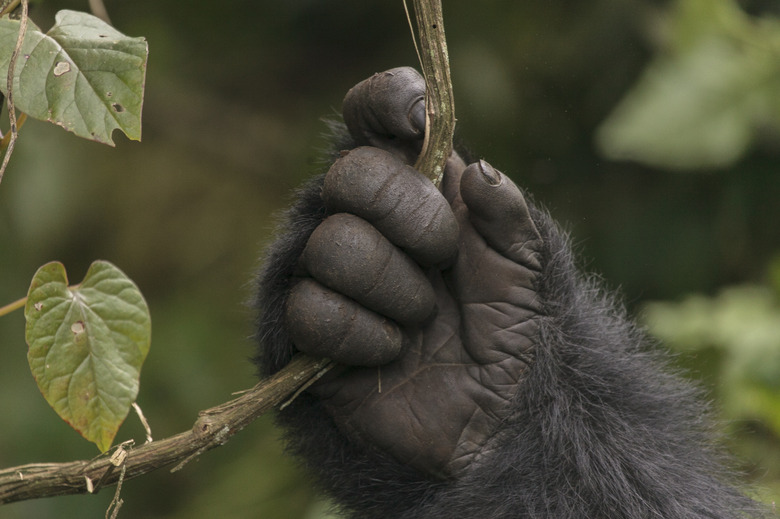Human Vs. Primate Hands
At a glance, the human and primate hands may seem nearly identical. They share a number of characteristics and both can grasp and perform a number of other functions. But several differences set the two hands apart.
Thumbs
Thumbs
Both primate and human hands have opposable thumbs, or thumbs that can move to touch the other four digits on the hand. But the human thumb is longer, more muscular and more mobile than the primate thumb. The longer human thumb would be hindrance for primates, according to the Hand Research website, getting in the way of the hook-like grasp they need for swinging from the trees.
Fingers
Fingers
Each hand features four fingers in addition to the opposable thumb, but the human fingers are shorter and flatter. The primate's longer, curved fingers assist with the animal's ability to swing through the trees, Hand Research says.
The digit ratio also differs. The digit ratio compares the lengths of the second and fourth fingers, or index and ring fingers, and is represented by the notation 2D:4D. The primate's 2D:4D is generally lower than human's. Human fingers can flex and rotate towards the center of the palm to touch the thumb. Primate fingers are not as mobile.
Prints
Prints
The human hand and primate hand both have finger prints and palm prints, or palmar whorls, but the prints differ. Human fingerprints have a higher ride density than primate fingerprints, which means the print ridges, or lines, are closer together. While the human's prints are denser, primates usually have more lines overall. Primate palms also have more creases, or simian lines, than the human palm, the Your Fingernails website says.
Movement
Movement
The human hand is much more mobile than the primate hand, according to the Journal of Anatomy. Humans can fully rotate their hands as well as extend and flex their hands at the wrist. Primates–especially those that walk on the knuckles of their hands–are not as flexible with their hand movements. The wrist bones of the knuckle-walkers keep their hands from bending or extending while they put pressure on their knuckles.
Development
Development
Human and primate hands were once much more similar than they do today, explained the Journal of Anatomy. While the primate hand stayed the same, the human hand changed to adapt to new functions. Using tools, clubs and throwing objects factored into the human-hand development, resulting in a longer thumb, more flexible finger and the ability to rotate the wrist and fingers.
Cite This Article
MLA
Gargulinski, Ryn. "Human Vs. Primate Hands" sciencing.com, https://www.sciencing.com/human-vs-primate-hands-6137415/. 13 March 2018.
APA
Gargulinski, Ryn. (2018, March 13). Human Vs. Primate Hands. sciencing.com. Retrieved from https://www.sciencing.com/human-vs-primate-hands-6137415/
Chicago
Gargulinski, Ryn. Human Vs. Primate Hands last modified March 24, 2022. https://www.sciencing.com/human-vs-primate-hands-6137415/
